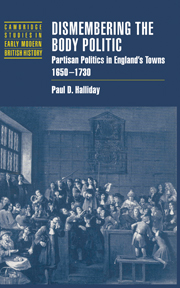Book contents
- Frontmatter
- Contents
- Preface
- List of abbreviations
- Part one Corporate ideal and partisan reality
- Part two The King and his corporations, 1660–1688
- Part three Partisan conflict and the law in a dynamic society
- 8 The legacy of the 1680s
- 9 Partisan conflict and political stability, 1702–1727
- 10 1660, 1688, 1727, and beyond
- Appendix A Royal charters of incorporation, 1660–1727
- Appendix B Enforcement of the Corporation Act, 1662–1663
- Select bibliography
- Index
- Titles in the series
10 - 1660, 1688, 1727, and beyond
Published online by Cambridge University Press: 10 November 2009
- Frontmatter
- Contents
- Preface
- List of abbreviations
- Part one Corporate ideal and partisan reality
- Part two The King and his corporations, 1660–1688
- Part three Partisan conflict and the law in a dynamic society
- 8 The legacy of the 1680s
- 9 Partisan conflict and political stability, 1702–1727
- 10 1660, 1688, 1727, and beyond
- Appendix A Royal charters of incorporation, 1660–1727
- Appendix B Enforcement of the Corporation Act, 1662–1663
- Select bibliography
- Index
- Titles in the series
Summary
One King died and another succeeded him; there were parliamentary elections. But 1727 was a year of little significance. So too were most of the other dates we use to separate epochs: 1688, 1714–15, 1722. Much happened in these years. Monarchs came and went, corporations were purged, corporation members sued one another, elections were held. Particularly in 1688–89 and 1714–15, moments marking important turnings in the nation's life, little else changed when the leadership did. Tories certainly fared worse after 1715 in parliamentary and court politics, but tory partisan groups in the corporations, and moreover, toryism among the broader populace, kept partisan competition alive and well beyond Westminster. The tone of political discord softened in the 1720s, and religious indentification ceased to be the chief determinant of the right to participate in public life. Partisan conflict was about different things by the late 1720s and 1730s, but partisan conflict endured as the basis of politics in the corporations. It is this continuity in political practice across 1688–89 and 1715 that makes an epoch of the seven or eight decades after 1650 that we otherwise treat as three or four distinct eras.
Partisan politics, born in the maelstrom of civil war, had outlived all the purges and amputations that had been intended to kill it in 1660 and the decades following. Though condemned by all, partisan politics flourished, and nowhere more prominently than in the corporations. It did so because it did not produce the consequences all feared it would.
- Type
- Chapter
- Information
- Dismembering the Body PoliticPartisan Politics in England's Towns, 1650–1730, pp. 342 - 349Publisher: Cambridge University PressPrint publication year: 1998

